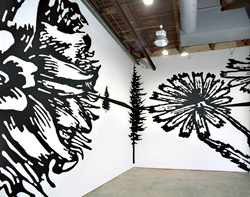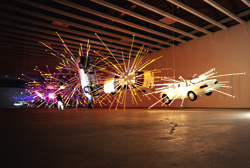with “Boys and Flowers,” the gallery’s sixth show since it opened in 2004, Western Bridge lets in a ripple of fresh air. It’s quite a departure from the dark realism of its previous show, “Crash. Pause. Rewind.,” which focused on modern violence. Instead, we have overpowering flowers that dwarf you, naughtiness in a bathhouse maze, and a wildly ambitious plan to replace a long-razed hill in a historic local park. Fanciful about sums it up. After a long, wet winter, three years of war, and hurricanes, maybe a bit of fancy is what we all need.
Western Bridge has a habit of hanging a small but arresting piece of work on the entrance wall. This time, it’s a stunning silver gelatin photo of a drooping tulip by Robert Mapplethorpe that introduces the show’s theme with a quietly sensual flair.
But it’s Paul Morrison’s mesophyte, a towering black-on-white mural which clambers across the walls of the vast main gallery, that clearly and fittingly steals the show. The sharply painted forms curl and unfurl as ferns, dandelion leaves, conifers, and flowers, then magnify up close into voluptuous curves. The London artist’s primeval jungle dominates the gallery with a mesmerizing primitive power. WB, in fact, needs to figure out a way to preserve this work after the show closes in August. Maybe owner-collectors Bill and Ruth True should ask Universal Nonlinear Design’s Jerry Garcia to design a faux wall or window to temporarily cover it during other installations.
Speaking of UND, they’re the mad geniuses behind another project on display here: the reconstruction of Denny Hill, a mildly insane proposal—though no more outrageous than the idea of razing the giant hill in the first place, as our city did with much effort and expense 75 years ago. The model itself is quite pretty, with its wooden topographical layers and copper mesh trees. And as the handsome accompanying booklet explains, this isn’t just a conceptual exercise. UND’s motives are rooted in concerns of environmental and historical justice, restoring the integrity of a ravaged natural space, using fill from the Alaskan Way Viaduct once it’s torn down—fill that came from Denny Hill in the first place. Demolishing the viaduct, of course, is perhaps the most quixotic aspect of the whole idea.
In a completely different vein, local eccentric Jeffry Mitchell’s idiosyncratic sources of high and low inspiration are on display in his tribute to the Club Z bathhouse, slated for closure, on Pike Street. Naked creatures (more teddy-bear-like than human) with erections pose and pry in a maze of rooms coyly placed behind Mitchell’s handmade Japanese byobu screen, whose delicious white side, decorated with elephants playfully spouting water alongside the mildly racy lyrics from Prince’s “Alphabet Street,” looks as though it could have been decorated with a pastry bag. (It recalls this writer’s crucifix-shaped First Communion cake, a testament to the weird and wonderful power of unintentional subjective associations.) It’s hard to say precisely what it all adds up to, but it makes for a fun little peepshow.
The Four Seasons of Veronica Read pulls you in with its geometric presentation: a square of screens on which the video’s four seasons are viewable on both sides. Standing in this visual box is an enticingly dizzying experience (enhanced further by the slurred sensibility of a reasonably strong opening night margarita). Filmmaker Kutlug Ataman’s British subject chats away, admirably focused on her passion—her amaryllis bulbs, to which she is both devoted and allergic. She’s the sort of character Nick Park might lovingly incarnate in clay in his Wallace & Gromit series. (In fact, I think he has.) In her own way, Read is as exotic in her domestic obsessions as the flowers she cultivates.
The least intriguing pieces in the show are the most literal, which tend to be the garden photos. Scott McFarland’s 14-foot panoramic view of Huntington Gardens in Pasadena, for instance, is impressive for its size and crisp focus, but strangely uninteresting in subject and framing. Though there aren’t a lot of deep issues here to ponder, “Boys and Flowers” is a nice reminder of the role of artists as sensualists and visionaries, and the joy of going along for the ride.








